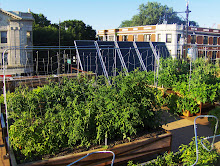In the mean time, while we are awaiting spring veggies, I thought I'd go back and tell you all about the cold frame building workdays that we had in late March. I never got the chance to show fully what we did and how it is turning out.

On March 25 and 26 we had a group of volunteers that showed up in the cold to help us build out 2 coldframe/low tunnels over a few of our raised beds on the roof. The tunnels turned out to be really easy to construct and we had way more than enough hands to do so.
We started with the following supplies:
3mm thick plastic sheeting
1/2" conduit piping, in 10' lengths (this acts as the spine at the top of the coldframe)
1/2" conduit piping, in 2' lengths
90degree conduit connectors
1/2" rebar stakes, 18" in length
1/2" PVC piping, in 8' lengths
2"x1" wood slats, in 5' lengths
Zipties
Because we built these coldframes on top of raised beds they didn't need any sort of intense anchoring, the wood frame of the boxes was enough. If you build these on the ground then they need a more intense frame/anchor system that will make sure they stay in place.
The first step was building the conduit pipe spine, which anchored into the boxes in the same location that the trellis system would be. Then we tapped in the rebar, directly against the wood boxes, down into the soil a full 12". The PVC pipes got bent over the center conduit piece and then connected with the rebar, which goes inside the PVC pipes 6" deep. The PVC pipes were then ziptied to the center conduit piece, to keep everything in place, even in Chicago winds. The plastic was cut to fit the boxes and then laid over the pipe system. At each end the plastic was ziptied to the PVC pipes, to ensure that it stays put for the season. We used the staple gun to attach the wood 2"x1"'s to the bottom of the plastic sheeting on the long sides of the beds, this acts to keep the plastic walls weighted down. To make it easy to access we used plastic clips on each corner to hold the plastic in place. These can be easily taken off and the plastic walls lifted up to plant, water and check on the veggies! The photos will explain some of the details, and if you have questions about it just let me know!











No comments:
Post a Comment